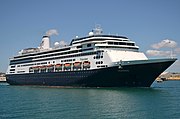 A typical Victory ship | |
| History | |
|---|---|
| Name | India Victory |
| Namesake | India |
| Ordered | as a Type VC2-S-AP2 hull, MCV hull 527 [1] |
| Builder | Permanente Metals Corporation, Richmond, California |
| Laid down | 4 March 1944 |
| Launched | 15 May 1944 |
| Completed | 29 July 1944 |
| Identification |
|
| Fate | Ran aground in South China Sea in storm 12 July 1972 |
| General characteristics | |
| Class and type | Victory ship |
| Displacement |
|
| Length | 455 ft (139 m) |
| Beam | 62 ft (19 m) |
| Draft | 29 ft 2 in (8.89 m) |
| Installed power |
|
| Propulsion |
|
| Speed | 15.5 kn (17.8 mph; 28.7 km/h) |
| Capacity |
|
| Armament |
|
SS India Victory was a Victory ship built and operated as a cargo carrier and troopship in World War II. After the war the ship was used a private cargo ship. She sank on 12 July 1972, ran aground on a Pratas Reef in the South China in Typhoon Susan. [2]
